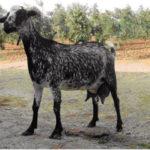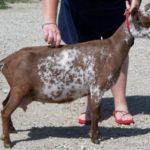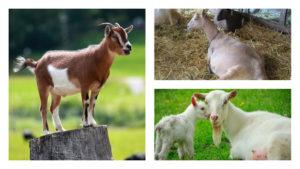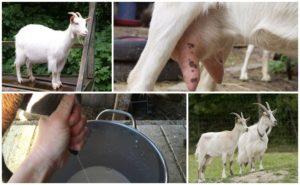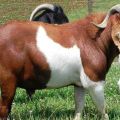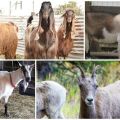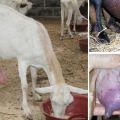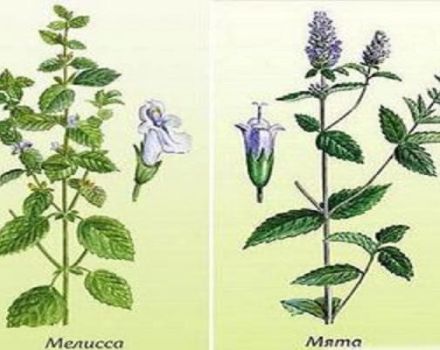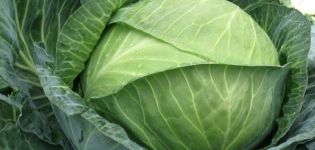Names and types of colors of speckled goats, which affects the color of animal hair
In addition to goats with a solid color of the same color, there are animals with marks. They are called "speckled goats" because of the specks that cover them. Obtaining a certain color is not a random process, but is subject to genetic laws. By crossing certain types of goats, you can get a large palette of goat hair colors. Knowing the laws of genetics, you can get the desired speckled color.
What affects the color of the goat
Genetics is the cornerstone of all "staining" processes. Genes interact with each other to give goats a particular shade of coat. Melanin is responsible for "relaying" this interaction in the goat's body. This pigment has a complex structure and is divided into 2 subspecies: zumelanin and pheomelanin.
Zumelanin "generates" black color, and pheomelanin is responsible for the "introduction" of red, yellow, orange. The color depends on the ratio of these types of melanin in the animal's body.
The chromosome is broken down into distinct regions called "loci". Each area is assigned a Latin letter. Genes are located at some loci. In addition to region A, genes located in B, S, M are also responsible for the shade of the coat. A gene can take various forms or alleles.
The animal has 2 chromosomes. In each of them, at the loci responsible for the color of the coat, different alleles are located. The shade depends on their combination. Alleles can be dominant or recessive. Depending on their interaction, dominant traits can completely suppress recessive traits or form a joint tandem.
Types of goat colors
Locus A contains alleles that change the color of the goat from white to black. The main, or dominant, color is white, the corresponding allele is designated "Awt". All variants of genes in locus A are presented in the table below. The first, white allele is the main or dominant one. As the value in the table decreases, the significance of the gene decreases. If the tandem consists of two different alleles, then the one above will be determining.
| № | Allele designation | Received color | Color names |
| 1 | Awt | White, may be yellow | White |
| 2 | Asb | Usually the animal has a light belly, face, legs. | Sable |
| 3 | Abm | Similar to Awt, but with dark markings on head, back or chest. | Black mask |
| 4 | Asr | Dark yellow or brown, with stripes on the lower torso or on the head. | Caramel |
| 5 | A + | It is similar to the previous type, but has a light back and belly. | Wild |
| 6 | Ab | Also similar to Asr, but with wide dark badger stripes in the lower abdomen and on the back. | Badger marks |
| 7 | Ats | Similar to Ab, but stripes run along the silhouette of the animal, bordering the body. | Tan sides |
| 8 | Asc | Here, dark specks are located on the legs and in front, light ones on the face. | San Clemente |
| 9 | Arp | Here, the entire front is dark, and the back is light with dark patches. | Repartis |
| 10 | Apk | "Reverse" to Arp. Front - light, back - black. On the head there are 2 dark markings. | Peacock |
| 11 | Asg | Symbiosis of small dark and white specks all over the body, except for the neck, head, legs. | Speckled gray |
| 12 | Ag | Here the specks are distributed throughout the body. Dark areas are located on the legs and head. | Gray |
| 13 | Aga | Similar to the previous type, but the legs are darkened. | Gray agouti |
| 14 | Asm | Uniform color, but there are white or gray markings on the tail, head, legs. | Swiss marks or Toggenburg |
| 15 | Aeb | Similar to Asm, but mottles are light or light brown. | Eyebrows |
| 16 | At | Black with red specks. | Tanned |
| 17 | Afsh | Dark with red stripes. | Dim |
| 18 | Als | Similar to Afsh, but lighter legs. | Side stripes |
| 19 | Am | Mixed black and red colors. | Mahogany |
| 20 | Arc | The body is all dark, only there are red areas on the cheeks. | Red cheeks |
| 21 | Aa | Absolutely black animal, no blotches. | The black |
In addition to the A site in the chromosome, the color is influenced by B, S, M. B changes color to black or brown. If the goat has black genes, this locus changes their shades of brown. There are 4 options in total B. Locus S influences whether the goat will be solid color or spotted, speckled. The large “S” indicates solid color, and the small “spot” color. M affects color saturation. Allele MM increases saturation, and Mm weakens.
